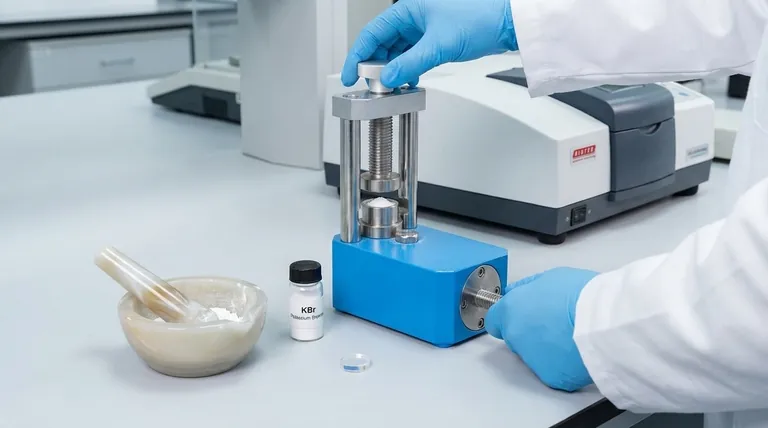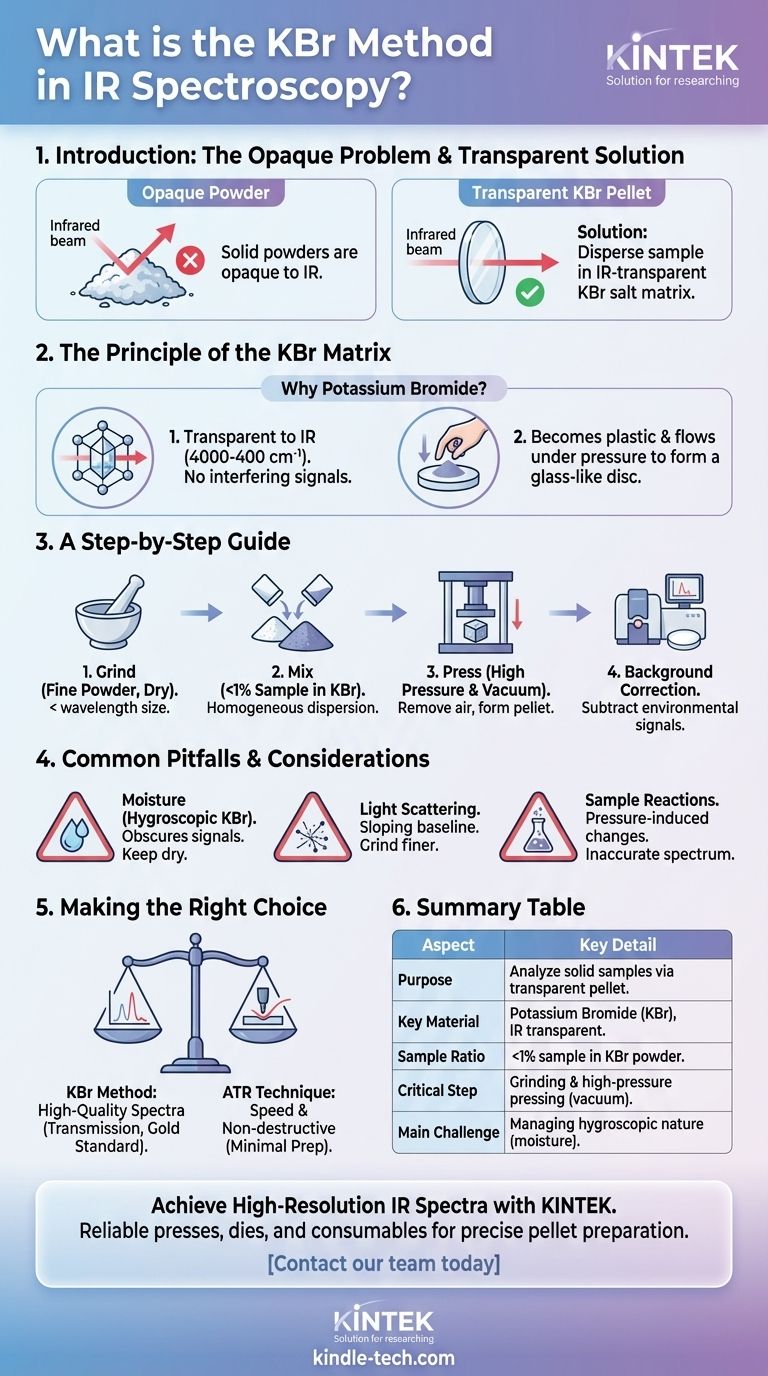在红外(IR)光谱法中,KBr法是一种用于分析固体材料的样品制备技术。它涉及将少量样品与溴化钾(KBr)粉末一起精细研磨,然后在高压下将混合物压制成一个薄而透明的压片。然后可以将该压片直接置于光谱仪红外光束的路径中进行分析。
使用红外光谱分析固体粉末的核心挑战在于它们通常是不透明的。KBr法通过将样品分散在红外透明的盐基质中来解决这个问题,有效地将粉末变成红外光可以穿过的“窗口”。
KBr基质的原理
为什么选择溴化钾?
溴化钾(KBr)是该技术的标准选择,原因有两个关键。首先,它在最常见的分析范围(4000-400 cm⁻¹)内对红外辐射是透明的,这意味着它不会产生自身的干扰信号。
其次,KBr和其他碱金属卤化物的一个独特之处在于它们在巨大压力下会变得有塑性和流动性。这种特性使得细粉末能够熔合在一起形成一个坚固的、玻璃状的圆盘,将样品固定在原位。
目标:均匀分散
该方法的最终目标是制备一个压片,其中样品的微小颗粒在KBr基质中均匀且稀薄地分布。
适当的分散可以最大限度地减少光散射,并确保红外光束与代表性的样品量发生相互作用,从而产生清晰准确的光谱。

方法的分步指南
步骤 1:研磨样品
为了获得良好的结果,样品和KBr都必须是极其干燥和精细研磨的。通常,使用玛瑙研钵和研杵将样品研磨成粒径小于红外辐射波长的粉末,以减少散射。
步骤 2:混合
将少量研磨后的样品(通常低于1%)添加到大量的干燥KBr粉末中。将两者充分混合和研磨,以确保样品均匀分散。
步骤 3:压制压片
将混合物放入模具中,然后放入液压机中。通常会对模具施加真空以去除截留的空气和水分,因为它们可能导致压片不透明或引入光谱干扰。
压机施加数吨的力,使KBr塑化并形成含有样品的透明压片。
步骤 4:背景校正
在分析样品之前,需要运行背景光谱。这可以通过一个空压片架或理想情况下通过一个由纯KBr制成的“空白”压片来完成。此步骤允许仪器的软件减去来自大气中的CO₂、水蒸气或KBr本身中杂质的任何信号。
常见陷阱和注意事项
水分的挑战
KBr是吸湿性的,这意味着它很容易吸收大气中的水分。水在红外光谱中具有非常强的吸收带,很容易掩盖样品中重要的信号。
所有设备,包括KBr粉末和样品,都必须保持严格干燥,通常通过将它们存放在烘箱或干燥器中。
光散射效应
如果样品颗粒研磨得不够细,它们会散射红外光束而不是吸收它。这会导致光谱质量差,出现基线倾斜和信号强度降低,使解释变得困难。
样品反应的可能性
用于形成压片的高压有时可能会引起样品中化学或物理变化。某些化合物可能会与KBr本身发生反应,导致产生的不准确的光谱不能代表原始材料。
根据您的目标做出正确的选择
KBr法是一种强大、经典的技术,但现代替代方法也存在。您的选择完全取决于您的分析需求。
- 如果您的主要关注点是高质量、高分辨率的光谱: 仔细执行的KBr法是固体透射测量的黄金标准。
- 如果您的主要关注点是速度和无损分析: 衰减全反射(ATR)等技术通常更优越,因为它几乎不需要样品制备。
- 如果您的样品对湿气或压力敏感: 您必须对KBr法采取极端预防措施,或选择替代技术以避免伪影。
了解KBr法的原理,可以帮助您从固体样品中生成清晰、可靠的光谱数据。
摘要表:
| 方面 | 关键细节 |
|---|---|
| 目的 | 通过制备透明压片,在红外光谱中分析固体样品。 |
| 关键材料 | 溴化钾(KBr),对红外光透明。 |
| 样品比例 | 通常<1%的样品分散在KBr粉末中。 |
| 关键步骤 | 研磨成细粉末,并在真空下施加高压。 |
| 主要挑战 | 管理KBr的吸湿性以避免水分干扰。 |
准备好从您的固体样品中获得高分辨率的红外光谱了吗? KBr法是一项基础技术,拥有正确的设备对于成功至关重要。KINTEK专注于提供可靠的实验室压机、模具和耗材,以实现精确的压片制备。
我们的专家可以帮助您选择最合适的工具,以最大限度地减少水分问题,并确保均匀的压片,从而获得清晰、准确的结果。
立即联系我们的团队讨论您实验室的需求,并提升您的红外光谱能力!
图解指南




















